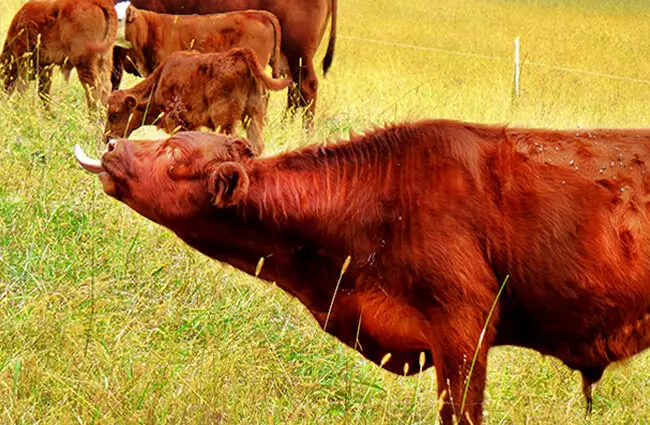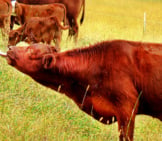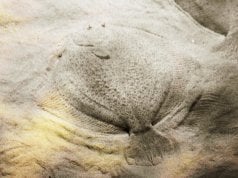The Red Angus is a breed of domestic cow. It has a separate registration from the related black angus. Researchers classify all domestic cattle under the scientific name Bos primigenius taurus.
All breeds of domestic cattle are members of the Bovidae family. Other members of Bovidae include bison, sheep, buffalo, antelope, impala, and more. Researchers believe that our domestic cattle descended from the wild aurochs, which is now extinct. Read on to learn about the Red Angus.
Description of the Red Angus
This cow is a large hoofed mammal, with a reddish colored coat. It has a thick, muscular body that people utilize for its meat production. Males grow larger than females, with the average male, or bull, weighing about 1,800 lbs. and the average female, or cow, weighing about 1,200 lbs.
Interesting Facts About the Red Angus
This breed has a number of interesting traits and characteristics. Learn more about what makes this cow unique, below.
- Turmoil in the Angus Community – This breed comes from the same stock as black angus cattle. However, in 1917, the Angus studbook decided to ban any red individuals to create an all-black breed. In response, farmers of Red Angus developed their own herdbook in 1954.
- Polled – Like their relatives, this breed of angus also naturally lacks horns. Farmers refer to this trait as “polled” and it helps save them the time and money involved in dehorning calves for safety.
- Aberdeen Ancestors– This breed originates from the Aberdeen Angus breed in Scotland. Red individuals from this lineage bred selectively to other red or red-carriers resulted in the production of the Red Angus.
Habitat of the Red Angus
People developed this breed of cattle from other domestic cows. For this reason, they have no “natural” habitat. People keep these animals on manmade and managed properties with grass for them to eat. Nowadays, cattle live in pastures and ranges of open area. As long as they have lots of space and plenty of grass, these creatures thrive.
Distribution of the Red Angus
People originally developed this breed from other domestic cattle. For this reason, they do not have a wild distribution or range. The original ancestors of this breed came from Aberdeen in Scotland. They quickly gained popularity and spread throughout the country and the world.
The development of the red line of this breed began in the United States. Breeders in Australia quickly followed suit, creating their own Red Angus Society as well.
Diet of the Red Angus
Cattle are herbivores, which means they only eat plants. As herbivores, they primarily graze for grass, rather than browse on plants and shrubs. They spend part of their day grazing, and the other part resting and re-chewing the food they just ate. They regurgitate their food, or cud, and chew it to aid digestion.
Red Angus and Human Interaction
As domestic animals, this breed would not exist without human interaction. People selected naturally hornless cattle with rapid muscle growth and high-quality meat, breeding only the best-quality animals. Breeders also selected specifically for cattle with red coats, finally developing this breed.
People use this cow for meat production.
Domestication
People originally bred this strain of cattle in Aberdeen, Scotland. The development of the breed began in the 1800s and quickly gained popularity. You could find these cattle in the surrounding countries by the mid-20th century.
Though people regularly bred red variants of black angus, the breed did not establish its own Association until 1954 in the United States and 1970 in Australia.
Does the Red Angus Make a Good Pet
People did not breed this type of cattle as a pet. Though they usually have friendly dispositions, the breed as a whole was developed with the purpose of meat production. Most people keep these cows for that purpose, and not as pets.
Red Angus Care
These animals require extensive care and space because they are quite large. They are social animals, so must live in groups (called “herds”), and those groups must have lots of acreage to roam.
They need lots of grass to eat, and additional hay to supplement their diet if the grass is not optimal, especially in winter. The more cattle on a pasture, the more acreage you need to sustain them.
Behavior of the Red Angus
Like all cattle, these animals have diurnal behavior, and display the most activity during the day. They live in herds, and have social hierarchies of more dominant and less dominant animals. Herds of cattle spend much of their time foraging for food, and then resting while they chew that food a second time as cud.
As a whole, the breed tends to have a friendly and calm disposition. However, bulls can display dangerous levels of aggression, and you should always treat them with caution.
Reproduction of the Red Angus
Cattle have polygamous breeding systems. A single male breeds with all of the receptive females in his herd. After breeding, females have a nine-month gestation period before giving birth to a single calf or a pair of calves. The calf can stand soon after birth, and quickly begins walking and following its mother.
The mother weans the calf off her milk when it is about six months old. By the time the calf is a year old they are fully independent from their mother. At a year old they reach sexual maturity and can reproduce.


![Ah, Mom – all the other calves get to go! Red Angus cow and calf Photo by: U.S. Department of Agriculture [pubic domain] https://creativecommons.org/licenses/by/2.0/](https://animals.net/wp-content/uploads/2020/03/Red-Angus-6-650x425.jpg)
![This small herd of Red Angus live on a five-generation family farm in South Carolina. small herd of Red Angus Photo by: U.S. Department of Agriculture [pubic domain] https://creativecommons.org/licenses/by/2.0/](https://animals.net/wp-content/uploads/2020/03/Red-Angus-2-650x425.jpg)
![Closeup of a beautiful Red Angus cow Closeup of a beautiful Red Angus cowPhoto by: U.S. Department of Agriculture [pubic domain]https://creativecommons.org/licenses/by/2.0/](https://animals.net/wp-content/uploads/2020/03/Red-Angus-4-650x425.jpg)
![Ok, everyone smile and say ‘Cheese’! Herd of Red Angus Photo by: U.S. Department of Agriculture [pubic domain] https://creativecommons.org/licenses/by/2.0/](https://animals.net/wp-content/uploads/2020/03/Red-Angus-3-650x425.jpg)
![A young Red Angus calf nursing from his mother. A young Red Angus calf nursing from his mother Photo by: U.S. Department of Agriculture [pubic domain] https://creativecommons.org/licenses/by/2.0/](https://animals.net/wp-content/uploads/2020/03/Red-Angus-5-650x425.jpg)

![Ah, Mom – all the other calves get to go! Red Angus Cow And Calf Photo By: U.s. Department Of Agriculture [Pubic Domain] Https://Creativecommons.org/Licenses/By/2.0/](https://animals.net/wp-content/uploads/2020/03/Red-Angus-6-162x141.jpg)
![This small herd of Red Angus live on a five-generation family farm in South Carolina. Small Herd Of Red Angus Photo By: U.s. Department Of Agriculture [Pubic Domain] Https://Creativecommons.org/Licenses/By/2.0/](https://animals.net/wp-content/uploads/2020/03/Red-Angus-2-162x141.jpg)
![Closeup of a beautiful Red Angus cow Closeup Of A Beautiful Red Angus Cowphoto By: U.s. Department Of Agriculture [Pubic Domain]Https://Creativecommons.org/Licenses/By/2.0/](https://animals.net/wp-content/uploads/2020/03/Red-Angus-4-162x141.jpg)
![Ok, everyone smile and say ‘Cheese’! Herd Of Red Angus Photo By: U.s. Department Of Agriculture [Pubic Domain] Https://Creativecommons.org/Licenses/By/2.0/](https://animals.net/wp-content/uploads/2020/03/Red-Angus-3-162x141.jpg)
![A young Red Angus calf nursing from his mother. A Young Red Angus Calf Nursing From His Mother Photo By: U.s. Department Of Agriculture [Pubic Domain] Https://Creativecommons.org/Licenses/By/2.0/](https://animals.net/wp-content/uploads/2020/03/Red-Angus-5-162x141.jpg)













![Red Angus Closeup of a beautiful Red Angus cowPhoto by: U.S. Department of Agriculture [pubic domain]https://creativecommons.org/licenses/by/2.0/](https://animals.net/wp-content/uploads/2020/03/Red-Angus-4-100x75.jpg)

